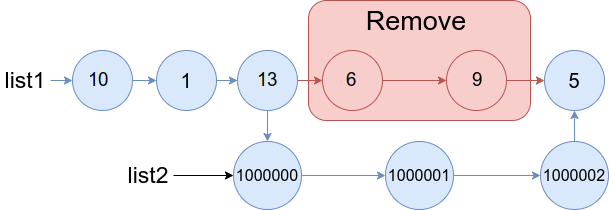- {x}
- Average Time of Process per Machine
- Check If Two String Arrays are Equivalent
- Smallest String With A Given Numeric Value
- Ways to Make a Fair Array
- Minimum Initial Energy to Finish Tasks
- Change the Root of a Binary Tree
- Fix Names in a Table
- Maximum Repeating Substring
- Merge In Between Linked Lists
- Design Front Middle Back Queue
- Minimum Number of Removals to Make Mountain Array
- Richest Customer Wealth
- Find the Most Competitive Subsequence
- Minimum Moves to Make Array Complementary
- Minimize Deviation in Array
- Lowest Common Ancestor of a Binary Tree IV
- Product's Worth Over Invoices
- Read More...

Merge In Between Linked Lists
You are given two linked lists: list1 and list2 of sizes n and m respectively.
Remove list1's nodes from the ath node to the bth node, and put list2 in their place.
The blue edges and nodes in the following figure indicate the result:

Build the result list and return its head.
Example 1:

Input: list1 = [10,1,13,6,9,5], a = 3, b = 4, list2 = [1000000,1000001,1000002] Output: [10,1,13,1000000,1000001,1000002,5] Explanation: We remove the nodes 3 and 4 and put the entire list2 in their place. The blue edges and nodes in the above figure indicate the result.
Example 2:

Input: list1 = [0,1,2,3,4,5,6], a = 2, b = 5, list2 = [1000000,1000001,1000002,1000003,1000004] Output: [0,1,1000000,1000001,1000002,1000003,1000004,6] Explanation: The blue edges and nodes in the above figure indicate the result.
Constraints:
3 <= list1.length <= 1041 <= a <= b < list1.length - 11 <= list2.length <= 104
1669. Merge In Between Linked Lists
Problem Description
Given two linked lists, list1 and list2, remove nodes from list1 starting from the a-th node to the b-th node (inclusive) and insert list2 in their place. Return the head of the modified list1.
Approach: Simulation
The solution directly simulates the merge operation. We traverse list1 to find the nodes just before the a-th node and the b-th node. Then, we link the node before a to the head of list2 and the tail of list2 to the node after b.
Algorithm
- Initialization: Two pointers,
pandq, are initialized to the head oflist1. - Finding the Split Points:
pis moveda-1steps to reach the node before thea-th node.qis movedbsteps to reach theb-th node. - Merging: The
nextpointer ofpis set to the head oflist2. - Finding the Tail of
list2: We traverselist2until we reach its tail (pwill now point to the tail oflist2). - Connecting the Tails: The
nextpointer ofpis set to the node afterb(which isq.next). - Cleaning up:
q.nextis set tonullto detach the removed section fromlist1. - Return: The head of the modified
list1is returned.
Time and Space Complexity
- Time Complexity: O(m + n), where 'm' is the length of
list1and 'n' is the length oflist2. We traverselist1to find the split points and traverselist2to find its tail. - Space Complexity: O(1). We use only a constant amount of extra space for pointers.
Code Implementation
Python
# Definition for singly-linked list.
# class ListNode:
# def __init__(self, val=0, next=None):
# self.val = val
# self.next = next
class Solution:
def mergeInBetween(self, list1: ListNode, a: int, b: int, list2: ListNode) -> ListNode:
p = q = list1
for _ in range(a - 1):
p = p.next
for _ in range(b + 1): #Corrected the loop condition here
q = q.next
p.next = list2
while p.next:
p = p.next
p.next = q
return list1
Java
/**
* Definition for singly-linked list.
* public class ListNode {
* int val;
* ListNode next;
* ListNode() {}
* ListNode(int val) { this.val = val; }
* ListNode(int val, ListNode next) { this.val = val; this.next = next; }
* }
*/
class Solution {
public ListNode mergeInBetween(ListNode list1, int a, int b, ListNode list2) {
ListNode p = list1, q = list1;
for (int i = 0; i < a - 1; ++i) p = p.next;
for (int i = 0; i <= b; ++i) q = q.next;
p.next = list2;
while (p.next != null) p = p.next;
p.next = q;
return list1;
}
}C++
/**
* Definition for singly-linked list.
* struct ListNode {
* int val;
* ListNode *next;
* ListNode() : val(0), next(nullptr) {}
* ListNode(int x) : val(x), next(nullptr) {}
* ListNode(int x, ListNode *next) : val(x), next(next) {}
* };
*/
class Solution {
public:
ListNode* mergeInBetween(ListNode* list1, int a, int b, ListNode* list2) {
ListNode* p = list1, *q = list1;
for (int i = 0; i < a - 1; ++i) p = p->next;
for (int i = 0; i <= b; ++i) q = q->next;
p->next = list2;
while (p->next != nullptr) p = p->next;
p->next = q;
return list1;
}
};(Other languages like Go, TypeScript, and C# would follow a similar structure, adapting syntax as needed.)
Note: The code examples provided are optimized for clarity and conciseness. Error handling (e.g., checking for null pointers or invalid input) could be added for robustness in a production environment.